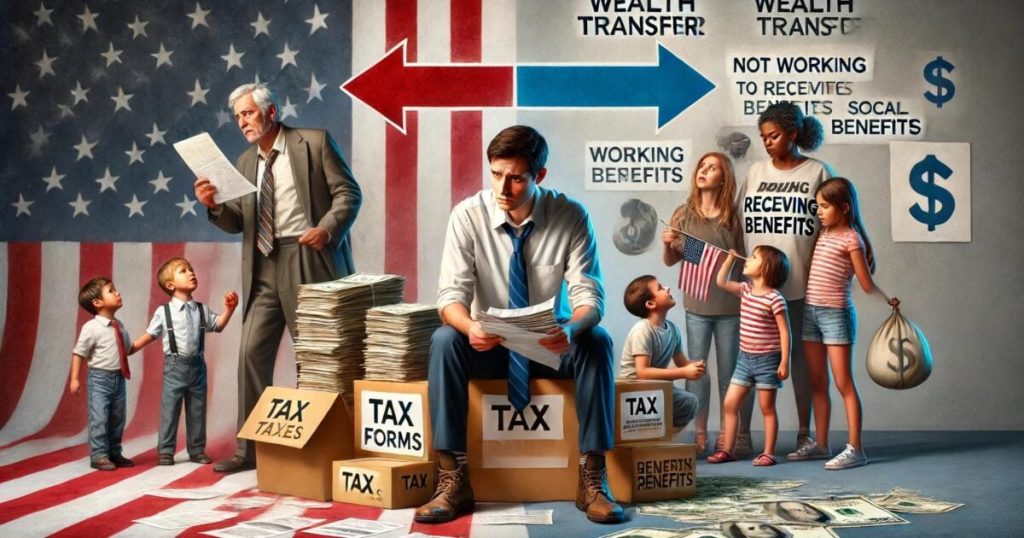Americans overtaxed, Courtesy of Antonio Graceffo
When you pay taxes, remember that the bottom 20% of income earners do almost no work, do not pay taxes, and receive government aid. The next lowest 20% pay minimal taxes but also receive government support.
Considering credits, the bottom half effectively pay about $667 per year. In contrast, the top 1% of income earners contribute roughly 38.8% of all federal income taxes, and the top 10% pay about 70% of the total federal income taxes. Most of the rest is paid by the Middle-income earners.
Households in the bottom 20% of income often pay little to no federal income taxes due to low taxable income and tax credits such as the Earned Income Tax Credit (EITC) and the Child Tax Credit (CTC). According to the Tax Policy Center, about 44% of U.S. households pay no federal income tax, largely because of these credits and deductions.
Many low-income households receive transfer payments from government programs like Medicaid, Supplemental Nutrition Assistance Program (SNAP), Temporary Assistance for Needy Families (TANF), and housing assistance.
In 2023, about 70.6 million Americans received benefits from programs administered by the Social Security Administration (SSA), including Social Security and Supplemental Security Income (SSI). Additionally, millions more benefit from other social safety net programs. For example, in the 2022 fiscal year, approximately 41.2 million people received SNAP benefits.
There is a claim that while low-income households may not contribute significantly to federal income taxes, they do contribute to other forms of taxation such as payroll taxes, sales taxes, and property taxes on their homes. However, these arguments are easily refuted.
The Social Security contributions of the low-income group are minimal because they earn less money and work less frequently. Middle-income and high-income groups pay more into Social Security, with the maximum contribution occurring at an income of $168,000.
Additionally, low-income workers can receive Supplemental Security Income (SSI), a needs-based program that provides cash assistance to disabled adults and children with limited income and resources. SSI is not dependent on work history or contributions to Social Security.
The property tax argument falls apart because the poor are less likely to own a home. Property taxes are used to fund public schools, so people who do not pay property tax can still send their children to schools funded by other people’s property taxes under Title I.
A counter-argument is that renters indirectly pay property taxes through their rent payments, which landlords use to cover property taxes. However, in the old tenement system, there was a building owner who paid property taxes.
In the new system of projects and state housing, the government is the owner, and no property taxes are paid. Therefore, all the funding for local schools must come from other taxpayers in other neighborhoods.
Middle- and high-income earners contribute significantly to payroll taxes, which fund Social Security and Medicare. Self-employed individuals pay both the employer and employee portions of these taxes, effectively paying double.
Middle- and high-income individuals often own businesses and create jobs, contributing to the economy and generating employment opportunities, while also paying the employer’s share of payroll taxes. This entrepreneurial activity supports economic growth and can lead to increased tax revenues.
Another cost that taxpayers must bear is crime. Evidence shows that higher crime rates are associated with lower-income areas. Property crimes and other criminal activities impose significant costs on taxpayers due to law enforcement, judicial processes, and correctional services.
Addressing crime and its social costs involves substantial public expenditure. However, individuals living in high-crime areas tend to pay little or no income tax. As a result, the cost of policing these areas falls on taxpayers in other neighborhoods, diverting money from public services in taxpaying areas to the policing of non-paying areas.
Research from the Center for Poverty and Inequality Research at UC Davis suggests that a significant portion of children who grow up in poverty and receive public assistance continue to rely on these programs into adulthood.
Approximately one-third to one-half of children who experience poverty for a substantial part of their childhood remain poor as adults. A study by the National Bureau of Economic Research (NBER) found that welfare receipt among parents significantly increases the likelihood of welfare participation among their children. This intergenerational correlation suggests that welfare use is, to some extent, a learned behavior, perpetuating the cycle of dependency.
In short, nearly the bottom half of the population is either paying no taxes, very little taxes, and/or receiving benefits. Every new social program for the non-payers represents a forced transfer of wealth from the working to the non-working and a transfer of government services from the taxpaying to the non-taxpaying.
The post The Bottom 20% Do Almost No Work, and You Pay for Them: How the Low-Income Bracket Drains Taxpayer Dollars appeared first on The Gateway Pundit.







